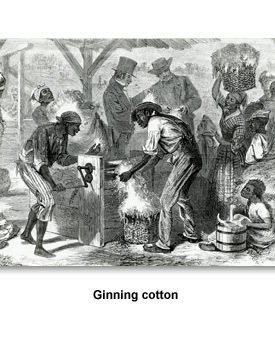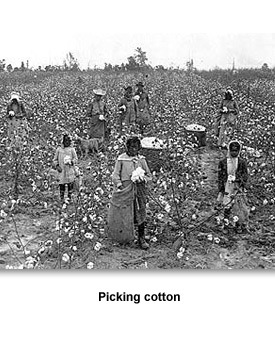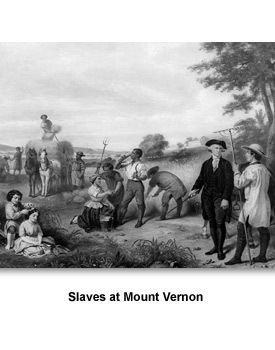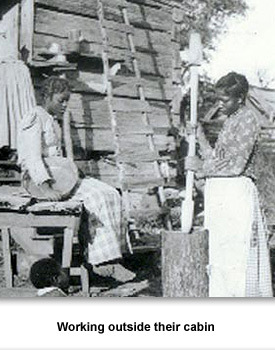Frontier
Slaves & Work
Slavery was different prior to statehood than it became afterward.
Slaves came into the state in small numbers and worked alongside whites at similar tasks. Enslaved men, armed with weapons, even helped defend fortifications against Indian attack. In addition, enslaved women performed jobs similar to white women.
Slaves came into the state in small numbers and worked alongside whites at similar tasks. Enslaved men, armed with weapons, even helped defend fortifications against Indian attack. In addition, enslaved women performed jobs similar to white women.
After Tennessee became a state in 1796, the climate began to change. Prosperity for some white men meant that more menial tasks could be left to slaves. Such work began to be seen as slave work.
Prosperity also created two areas of slave work in rich households—field work and house work. House servants helped the family with domestic tasks. The women would cook for their owner’s family, clean their houses, serve as a maid for the daughters, and take care of babies.
Susan Kelly, a former slave interviewed in the 1930s, said her job was to mind the children and put them to bed at night. “The baby had to be rocked before she would go to sleep, and I had to sing for her,” Kelly said.
Men usually served as waiters or butlers. One former house slave, Albert Jones, said his job was to wait on his master, drive the wagon, and tend his horses.
Men usually served as waiters or butlers. One former house slave, Albert Jones, said his job was to wait on his master, drive the wagon, and tend his horses.
Field hands, both skilled and unskilled, usually worked in outdoor chores, like farming and blacksmithing. They worked long hours in all types of weather. It was usually backbreaking work like picking cotton.
Large plantations had overseers who supervised the slaves’ field work. This overseer could be harsh—beating anyone they thought wasn’t working hard enough. While it was to the owner’s advantage to treat their slaves well so they would be able to work harder, some did not.
Others required slaves to work even when they weren’t feeling well. Some pregnant enslaved women worked up until it was time to give birth, and then were back in the field working the next day.
Women might work in the fields all day and then in the evening be expected to do sewing. Fannie Moore held a candle for light so her mother could sew quilts at night. "I never see how my manny [could] stand such hard work," she said years later.
Women might work in the fields all day and then in the evening be expected to do sewing. Fannie Moore held a candle for light so her mother could sew quilts at night. "I never see how my manny [could] stand such hard work," she said years later.
Most Tennessee farmers didn’t have any slaves to help them. Those that had one or two slaves did not have separate house and field workers. The slave had to do both house and field jobs. "That sure was hard work," said Mary Lindsay years after she was the only slave to a white blacksmith. "I have to get up at three o'clock sometimes so I have time to water the horses and slop the hogs and feed the chickens and milk the cows, and then get back to the house and get breakfast," Lindsay said.
Very often these owners would be working in the fields beside the slave. But the owner had the freedom to stop and take a break, and the slave could not without his owner’s permission.
Very often these owners would be working in the fields beside the slave. But the owner had the freedom to stop and take a break, and the slave could not without his owner’s permission.
Some slaves were hired out to other families. A former slave in Nashville said she was required to "cook, chop in the fields, chop wood, bring water, wash, and iron." She was six years old at the time.
In towns like Nashville, slaves often performed more specialized tasks, helping owners in trades like blacksmithing, butchering, driving wagons, or other types of work. After finishing the day, slaves often had free time to meet with friends or hire themselves out for other jobs. Some were able to purchase their freedom as a result.
As towns grew, slavery became less compatible with urban life. The larger the town, the more areas blacks could meet without white interference. Laws were passed to address this problem, but were unable to completely stop African Americans from meeting.
Small industry owners also used slave labor. David Ross established the first foundry in Tennessee, and primarily used slave labor. Ross employed men, women, and children in his foundry, but he was also known for treating his workers well and keeping families together.
Picture Credits:
- An engraving entitled "The first cotton gin" by William L. Sheppard. It shows two African American men working the cotton gin while two women bring more cotton to the gin. In the middle, two well-dressed white men look at ginned cotton. There is a small child holding a water bucket at the right. Library of Congress
- A photograph of African Americans picking cotton in a field in Georgia. It was copyrighted in 1907, but could have been taken earlier than that. Library of Congress
- An engraving of a painting showing "Washington's Slaves at Mount Vernon." The man on the right in a dark suit is George Washington. He is talking to his overseer while white children play on the left. In the middle, an African American woman gives two male slaves water from a bucket. Other workers are in the background. Library of Congress
- Photograph of women, identified as slaves, work outside their cabin. On the right, a young woman is grinding something in a mortar using a pestle. Library of Congress
Frontier >> Living on the Frontier >> How They Worked >> Slaves & Work




 Sponsored by: National Endowment for the Humanities
Sponsored by: National Endowment for the Humanities